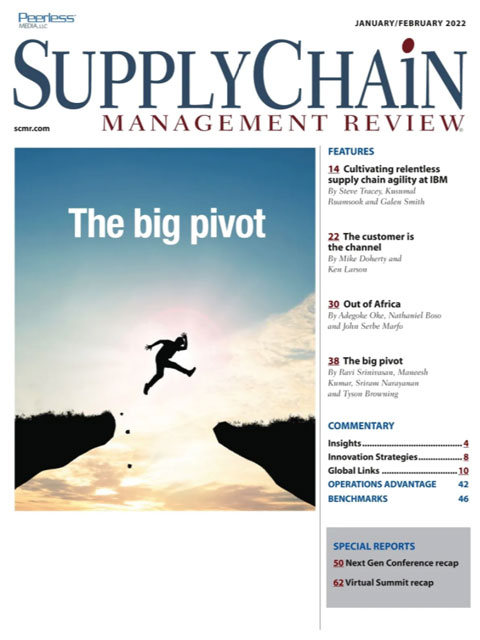Sorry, but your login has failed. Please recheck your login information and resubmit. If your subscription has expired, renew here.
January-February 2022
Well, that’s over, and aren’t we all glad to put 2020 in the rear-view mirror? For a minute, however, let’s look at a silver lining, because I think there is one for supply chain managers. That’s because the pandemic put supply chain in the spotlight like never before—and, with the approval of a vaccine just a few weeks ago in December, supply chain and cold chain are back in the news… While sales usually gets all the attention, maybe 2021 is our time to shine.” That’s the beginning of the column I wrote for the January 2021 issue, and maybe I was a little too pollyannish. Browse this issue archive.Need Help? Contact customer service 847-559-7581 More options
Employee attrition is a major pain point across supply chains, disrupting operations, undercutting companies’ increasingly expensive investments in recruitment and training and forcing the employees who stay into a never-ending scramble to fulfill their goals. It’s a scenario that fuels further attrition. In fact, many supply chain executives tell us that employee attrition is now their single biggest operational challenge.
The good news? You can turn attrition into retention via a formula that is powered by advanced analytics.
Treat the disease (employee engagement), not the symptom (attrition). Approaches based on backfilling vacant roles are rarely effective, often resulting in a race to the bottom with competitors and rising costs to recruit, onboard and retain employees. To break the costly cycle of paying a premium to attract labor, only to watch it walk out the door within months or weeks, learn what you must do to more fully and consistently engage people.
Identify root causes. Each step in the employee life cycle has an impact on engagement, and different employee subsets within the same role often choose to leave for different reasons. Advanced analytics and machine learning can help you see these segments and understand their respective causal factors.
Connect the dots. Pair analytics insights with observational and behavioral data to understand why employees are disengaged and/or turning over. For example: Do certain incentives unintentionally motivate recruiters, managers or employees to worsen your attrition problem?
Choose best levers. By this point, you will likely perceive a wide range of action options for increasing engagement and reducing attrition. The challenge now is weighing the complex trade-offs among these levers to understand which will yield the most rapid and sustainable gains, at affordable costs and with minimum disruption to your operations.
Re-engage with employees. Be highly communicative and transparent with your employees about why you have engaged in this process, what you have learned and how you will act on those insights to significantly improve the employee value proposition.

This complete article is available to subscribers only.
Log in now for full access or start your PLUS+ subscription for instant access.
SC
MR
Sorry, but your login has failed. Please recheck your login information and resubmit. If your subscription has expired, renew here.
January-February 2022
Well, that’s over, and aren’t we all glad to put 2020 in the rear-view mirror? For a minute, however, let’s look at a silver lining, because I think there is one for supply chain managers. That’s because the… Browse this issue archive. Access your online digital edition. Download a PDF file of the January-February 2022 issue.Employee attrition is a major pain point across supply chains, disrupting operations, undercutting companies’ increasingly expensive investments in recruitment and training and forcing the employees who stay into a never-ending scramble to fulfill their goals. It’s a scenario that fuels further attrition. In fact, many supply chain executives tell us that employee attrition is now their single biggest operational challenge.
The good news? You can turn attrition into retention via a formula that is powered by advanced analytics.
Treat the disease (employee engagement), not the symptom (attrition). Approaches based on backfilling vacant roles are rarely effective, often resulting in a race to the bottom with competitors and rising costs to recruit, onboard and retain employees. To break the costly cycle of paying a premium to attract labor, only to watch it walk out the door within months or weeks, learn what you must do to more fully and consistently engage people.
Identify root causes. Each step in the employee life cycle has an impact on engagement, and different employee subsets within the same role often choose to leave for different reasons. Advanced analytics and machine learning can help you see these segments and understand their respective causal factors.
Connect the dots. Pair analytics insights with observational and behavioral data to understand why employees are disengaged and/or turning over. For example: Do certain incentives unintentionally motivate recruiters, managers or employees to worsen your attrition problem?
Choose best levers. By this point, you will likely perceive a wide range of action options for increasing engagement and reducing attrition. The challenge now is weighing the complex trade-offs among these levers to understand which will yield the most rapid and sustainable gains, at affordable costs and with minimum disruption to your operations.
Re-engage with employees. Be highly communicative and transparent with your employees about why you have engaged in this process, what you have learned and how you will act on those insights to significantly improve the employee value proposition.
SC
MR


Latest Supply Chain News
Latest Podcast

 Explore
Explore
Topics
Business Management News
- Strengthening customer fulfillment: Building a strategic stakeholder network
- The hard job of teaching soft skills
- Trump picks former Wisconsin congressman Sean Duffy for DOT secretary
- Made in Mexico, manufactured by China
- Retail sales see gains in October, reports Commerce and NRF
- Balancing green and speed: Home delivery insights from the pandemic era
- More Business Management
Latest Business Management Resources

Subscribe

Supply Chain Management Review delivers the best industry content.

Editors’ Picks





